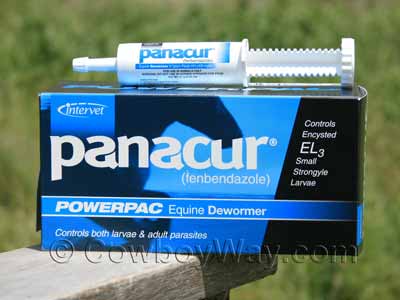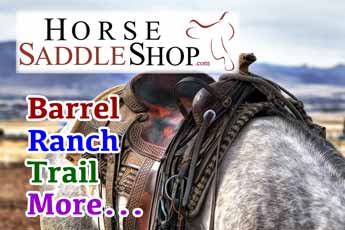What Is Larvicidal De-Worming Of Horses?
"Larvicidal de-worming" is a rather broad term used to describe the killing of worms or parasites in the larvae stage inside of our horses.
However, the term is often intended to be much more specific than simply killing any species of larvae at any stage. "Larvicidal de-worming" is frequently used by horse owners to specifically mean the killing of small strongyle larvae during the stage of development when they are buried in the horses' intestinal wall. This is frequently referred to as the "encysted" stage since cysts form around the larvae.
Disclaimer
CowboyWay.com does not warrant the accuracy or timeliness of any of the
information found on the CowboyWay.com website, and does not accept liability
for errors or omissions.
In addition, anything found on CowboyWay.com
is not intended to replace veterinary care for your horse or other animals. Always
consult a veterinarian or other trained animal health care professional
regarding any information that may be found here, and/or regarding the
health or care of your animals.
Life Cycle Of The Small Strongyle
The more researchers learn about encysted small strongyles, the more reasons horse owners have to hate them. Before we go any further, it's going to be helpful to understand the life cycle of the small strongyle:
- Adult small strongyles lay eggs inside of the horse that are passed into the horse's feces and subsequently dropped into pastures, stalls, etc.
- The eggs hatch and go through several stages of development. During the stage when they are known as "third-stage" larvae (L3) they are ready to be ingested by a horse. Once inside, they migrate into the horse's intestinal wall.
- When the third-stage (L3) small strongyle larvae have entered the intestinal wall, cysts form around them. The encysted larvae have an early stage (EL3) and a late stage (LL3) of development. While in the early third-stage of development the larvae can remain encysted in the horse's intestine for up to 3 years before they develop into the later stage.
- The larvae develop into a fourth stage (L4) of development and emerge from the cysts in the intestinal wall. They then develop into a fifth stage (L5), then adulthood where the lifecycle starts over again.
Damage and Death
Encysted small strongyles in the horse can cause significant inflammation, unexplained weight loss, diarrhea, poor hair coat, and in extreme cases death.
Even so, it is when the larva enter the fourth stage and emerge from the intestinal wall that they are even more of a threat to the horse. The damage caused by thousands or millions of these larvae emerging at once can result in colic, diarrhea, swelling, unexplained lethargy, sudden weight loss, and even death.
Since encysted small strongyles are not killed by typical de-worming procedures, and since they cannot be detected by fecal analyses, even conscientious horse owners on a regular de-worming program may be hit by surprise with encysted small strongyles.
Equine Illness After "Regular" De-Worming
Occasionally a horse will act listless or as though it doesn't feel well after it has been de-wormed (it's important to note here that we're talking about a "regular" de-worming, not a larvicidal de-worming as described below).
In the past, it was assumed that the cause of a horse acting as though it felt a bit "off" after being de-wormed was due to the results of a heavy parasite load being killed.
However, newer research suggests there could be a much more sinister cause.
Adult small strongyles in the intestine seem to have some way of communicating to their encysted brethren in the horse's intestinal wall. When the adult population is sufficient, the encysted larvae remain where they are.
But when the adult population is lowered (for example, after a de-worming) the encysted, stage three larvae (L3) are somehow prompted to develop into stage four (L4) larvae and emerge from their encysted state.
Many researchers now think that a horse who shows signs of listlessness or illness following de-worming may be experiencing large numbers of small strongyle larvae emerging out of their cysts.
Larvicidal De-Worming
To kill encysted small strongyles horse owners need to use a very specific de-worming procedure called "larvicidal de-worming." This is commonly done by administering twice the usual dosage of fenbendazole for horses once a day for 5 consecutive days. Fenbendazole for horses is marketed under the names of Panacur and Safe-Guard.
Currently, fenbendazole is the only FDA-approved product to treat all stages of encysted small strongyles in horses.
Do NOT consider giving any horse, foal, or pregnant mare a larvicidal dose of de-wormer (febendazole or any other) without first consulting your veterinarian. To do so could result in the death or severe illness or injury of the horse, foal, pregnant mare, or unborn foal.
Where To Buy Febendazole For Horses
As mentioned above febendazole for horses is marketed under the brand names of Panacur and Safe-Guard. Both of these products are commonly available from your veterinarian or local horse supply / veterinary supply store.
Panacur and Safe-Guard are both commonly sold in box sets that contain five 1-dose syringes, 57gm each, of febendazole for horses in paste form for oral administration.
- The box set of Panacur is called a "Power Pac."
- The box set of Safe-Guard is called a "Power -Dose."

When Is Larvicidal De-Worming Usually Done?
When or if a horse should be given a larvicidal dose of de-wormer can vary according to the age of horse, pregnancy status, overall health, and what is known about the horse's medical history.
For example, when some people purchase a new horse they may not know its vaccination or de-worming history, so they feel most comfortable giving it any vaccinations they feel it needs as well as de-worming it, including a larvicidal de-worming.
Some horse owners give their horses larvicidal doses of de-wormers once or twice a year as a part of their regular de-worming program. Consult your veterinarian to see what is best for your horse.
Related Terms And Information
- What is an anthelmintic?
An anthelmintic is a parasite killing drug. - What is "S. vulgaris?"
S. vulgaris is the abbreviation for large strongyles, not small strongyles. It stands for "Strongylus vulgaris." - What is "larval cyathostomosis"?
"Cyathostomosis" is another name for small strongyles, so "larval cyathostomosis" is referring to small strongyles in the larval state. Usually, the term is used to refer to the encysted stage of small strongyles and the health problems they cause. "Larval cyathostomosis" is sometimes also called "encysted cyathostomosis."
What Is / Are...
… What Are 5 Of The Biggest Wild West Robberies?
… What Are 5 Reasons Horse Trailer Lighting Matters?
… What Are 8 Dumb Things To Say To A Horse Lover?
… What Are 9 Proven Ways To Keep Flies Off Horses?
… What Are Chestnuts and Ergots?
… What Are The Parts Of A Western Saddle?
… What Are Saddle Rigging Positions?
… What Are Some Fencing Options?
… What Are Some Foods Both Horses And Dogs Can Eat?
… What Are Some Horse Fencing Basics?
… What Are Some Interesting Horse Facts?
… What Are Some Interesting Charts and Graphs With Horse Information?
… What Are Some Options For Temporary Horse Fencing?
… What Are Synthetic Saddles Made Of?
… What Are The Rodeo Catch Pens?
… What Are The 10 Best 3-Horse Trailers With Living Quarters In The USA And Canada?
… What Are The X's In A Cowboy Hat?
… What Are The Three Legal Head Catches?
… What Is The Angle System For Branding?
… What Is The Barrel Racing Pattern?
… What Is A Bull Riding Vest Made Of?
… What Is Deworming Your Horse?
… What Is A Domain Name?
Why would I need one for my farm or ranch even if I don't have or
want a website?
… What Is A Fifth Wheel Trailer Hitch?
… What Is Flag and National Anthem Etiquette At A Rodeo?
… What Is A Slant Load Horse Trailer?
… What Is Floating A Horse's Teeth?
… What Do Horse Freeze Brands Look Like?
… What Is A Galvayne's Groove?
… What Is A Gooseneck Trailer Hitch?
… What Is Some History About The First National Finals Rodeo?
… What Is The History Of The Modern, Hornless, Bronc Riding Saddle?
… What Is The History Of The Modern Rodeo Bucking Chute?
… What Is The History Of The One-Hand Bareback Rigging?
… What Is The Nasolacrimal Duct In Horses?
… What Is A Pony Express Mochila?
… What Is Hermann Oak Leather?
… What Is Larvicidal De-Worming?
… What Is The Flehmen Response?
… What Is The Rodeo Return Gate?
… What Is A Safety Tip For Posting The Colors?
… What Is A Slick Fork Saddle?
… What Is A Swell Fork Saddle?
You Might Also Like
